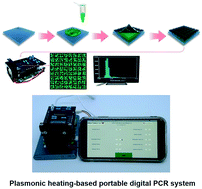Plasmonic heating-based portable digital PCR system†
Abstract
A miniaturized polymerase chain reaction (PCR) system is not only important for medical applications in remote areas of developing countries, but also important for testing at ports of entry during global epidemics, such as the current outbreak of the coronavirus. Although there is a large number of PCR sensor systems available for this purpose, there is still a lack of portable digital PCR (dPCR) heating systems. Here, we first demonstrated a portable plasmonic heating-based dPCR system. The device has total dimensions of 9.7 × 5.6 × 4.1 cm and a total power consumption of 4.5 W, allowing for up to 25 dPCR experiments to be conducted on a single charge of a 20 000 mAh external battery. The dPCR system has a maximum heating rate of 10.7 °C s−1 and maximum cooling rate of 8 °C s−1. Target DNA concentrations in the range from 101 ± 1.4 copies per μL to 260 000 ± 20 000 copies per μL could be detected using a poly(dimethylsiloxane) (PDMS) microwell membrane with 22 080 well arrays (20 μm diameter). Furthermore, the heating system was demonstrated using a mass producible poly(methyl methacrylate) PMMA microwell array with 8100 microwell arrays (80 μm diameter). The PMMA microwell array could detect a concentration from 12 ± 0.7 copies per μL to 25 889 ± 737 copies per μL.



 Please wait while we load your content...
Please wait while we load your content...